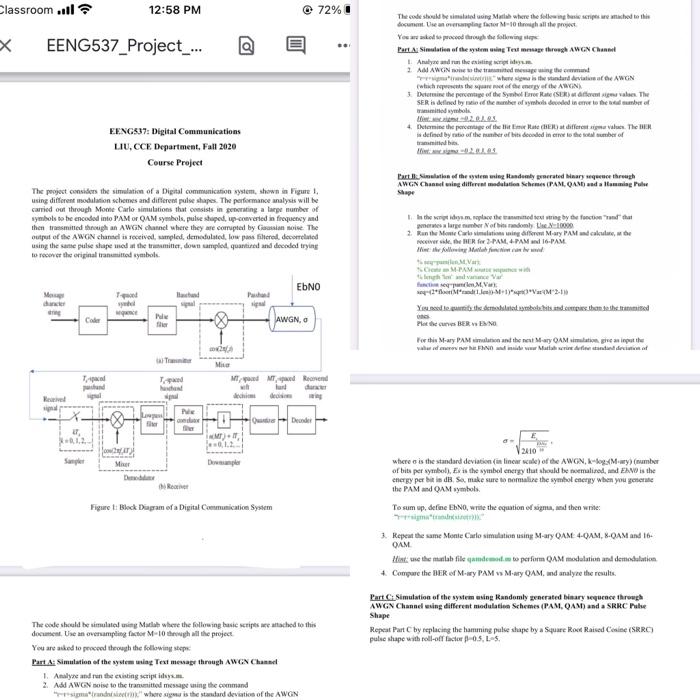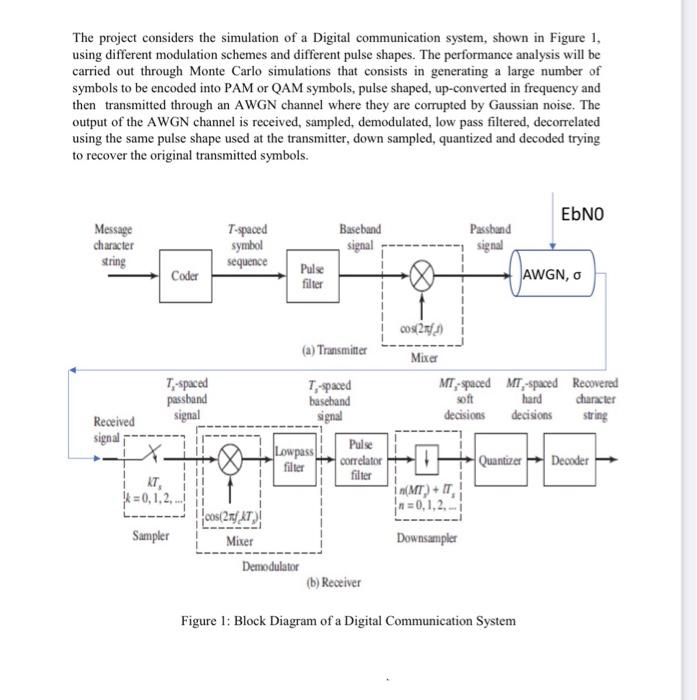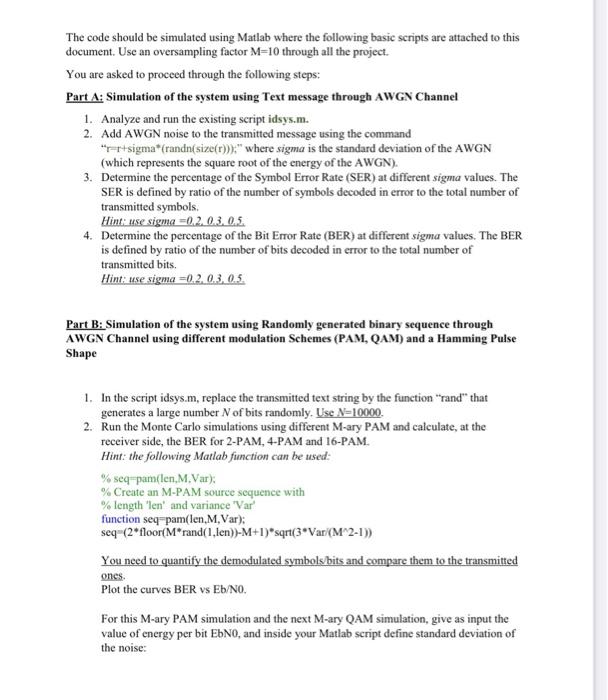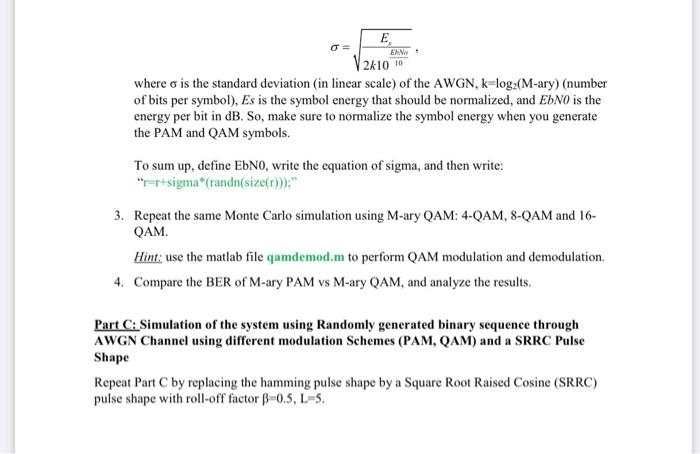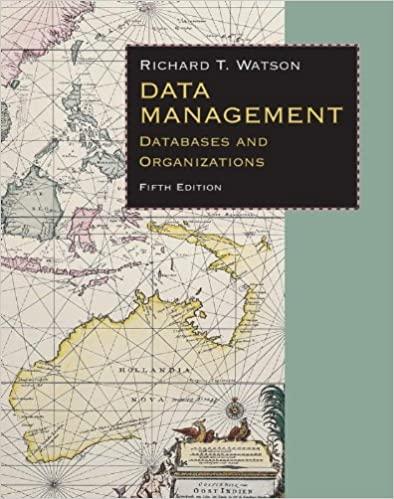Classroom 111 12:58 PM 72% EENG537_Project_... The code should be imated using Mati where the following busie series are ched to this document. Use anneling factor M-10 tigh all the project You to proceed through the fing Parts Simulation of the system wing Test map through AWGN Channel Amaland their 2. AAWN the trade in the where is the wonderd deviata e AWGN which the profil AWON Determine the percentage of the Seas (SR) forever. The SER is by chef hos dered into the dumber of wedwybol 2010 Determine the percentage of the trees at different. The defined by to of the mobile decoded into the lumber of trambi 4. EENG337: Digital Communications LIU, CCE Department, Fall 2020 Course Project Date Site of the wytem wing Randomly generated Hinary queence through AWGN Chandling different modelation Schemes (PAM. QANO anda lamming The project consider the simulation of a Digital communication system, shown in Figure 1. using different modulation schemes and different pulse shapes. The performance analysis will be carried out through Monte Carlo simulations that consists in generating a large number of symbols to be encoded into PAM or AM symbols, pulse shaped up.converted in frequency and then transmitted through an AWGNchannel where they are compted by Cassia noise The output of the AWGNchannel is received, sampled, demedulated, low pass filiera decorrelated using the same pulse shape med at the transmitter,down sampled quanted and decaded trying to recover the original tranmitted symbols. EDNO In the words. place the trading by the fact that eres larger Nordomly the 10000 2. Run the Monte Carlo mining from Mary PAM and call, we the fox-PAM, 4-PAM 16-PAM Infolin Matlab SMV MAM bhavance M.VE Med-1" VM2-18 Yesus deltoltottsandheld Plates BEREN For this M-ary PAM simulation and the next Mary OAM mange an input the waarderow hat Matatandandi Pule Code AWGN, T MTMT, Read will de Pie LI Dender IM) E Mer Depler V2110 where is the standard deviation in linear scale of the AWGN, kg:Mury) (number of bits per symbol). Ex is the symbol energy that should be nemalised, and is the energy per bis in ds. Sa, make sure to normalize the symbol energy when you generate the PAM and QAM symbol Figure Black Diagram of a Digital Communication System To sum up, define Eno, write the equation of sigma, and the write 3. Repeat the same Monte Carlo simulation using M-ary OAM: 4-QAM, 8.0AM and 16 OAM Hint: we the melab file andmade to perform QAM modulation and demodulation 4. Compare the BER of M-ayPAM Mary QAM, und analyze the results. Part Simulation of the system using Randomly generated binary sequence through AWGN Channel using different modulation Schemes (PAM, QAMD and a SRRC Pube Shape Repeat Part by replacing the hanming pulse share by a Square Root Raised Ceaine (SRRC polic shape with roll-of factor -0.5, LAS The code should be simulating Matlah where the following basic series we attached to this document. Use an overampling factor M-10 though all the project You are asked to proceed through the following Part A. Simulation of the system wing Text menage through AWGN Channel 1. Analyse and run the existing scriptis... 2. Add AWG noise to the traited message in the command siradok" where is the standard deviation of the AWGN The project considers the simulation of a Digital communication system, shown in Figure 1, using different modulation schemes and different pulse shapes. The performance analysis will be carried out through Monte Carlo simulations that consists in generating a large number of symbols to be encoded into PAM or QAM symbols, pulse shaped, up-converted in frequency and then transmitted through an AWGN channel where they are corrupted by Gaussian noise. The output of the AWGN channel is received, sampled, demodulated, low pass filtered, decorrelated using the same pulse shape used at the transmitter, down sampled, quantized and decoded trying to recover the original transmitted symbols. EDNO Message character string T-spaced symbol sequence Baseband signal Passband signal Coder Pulse filter AWGN, O (a) Transmitter 003/24/2) Mixer MT, spaced MT, spaced Recovered soft hard character decisions decisions string T-spaced passband signal Received signali T-paced basehand signal Pulse Lowpass filter correlator filter Quantizer Decoder KT, }=0,1,2, (MT) + IT, "=0,1,2.1 Sampler cos(27/JT) Mixer Demodulator Downsampler (b) Receiver Figure 1: Block Diagram of a Digital Communication System The code should be simulated using Matlab where the following basic scripts are attached to this document. Use an oversampling factor M=10 through all the project. You are asked to proceed through the following steps: Part A: Simulation of the system using Text message through AWGN Channel 1. Analyze and run the existing script idsys.m. 2. Add AWGN noise to the transmitted message using the command "r=rtsigma*(rand(size(t):" where sigma is the standard deviation of the AWGN (which represents the square root of the energy of the AWGN). 3. Determine the percentage of the Symbol Error Rate (SER) at different sigma values. The SER is defined by ratio of the number of symbols decoded in error to the total number of transmitted symbols. Hint: use sigma =0.2.0.3.0.5. 4. Determine the percentage of the Bit Error Rate (BER) at different sigma values. The BER is defined by ratio of the number of bits decoded in error to the total number of transmitted bits. Hint: use sigma =0.2.0.3.0.5. Part B: Simulation of the system using Randomly generated binary sequence through AWGN Channel using different modulation Schemes (PAM, QAM) and a Hamming Pulse Shape 1. In the script idsys.m, replace the transmitted text string by the function "rand" that generates a large number of bits randomly. Use N=10000 2. Run the Monte Carlo simulations using different M-ary PAM and calculate, at the receiver side, the BER for 2-PAM, 4-PAM and 16-PAM. Hint: the following Matlab function can be used: % seq=pamen, M. Var): % Create an M-PAM source sequence with % length "len' and variance Var function seq-pam(len,M,Var): seq (2*floor(M" rand(1,len))-M+1)*sqrt(3*Var (M^2-1)) You need to quantify the demodulated symbols bits and compare them to the transmitted ones Plot the curves BER vs Eb/NO. For this M-ary PAM simulation and the next M-ary QAM simulation, give as input the value of energy per bit EbNO, and inside your Matlab script define standard deviation of the noise: E EANO 2k10 where c is the standard deviation in linear scale) of the AWGN, k=log (M-ary) (number of bits per symbol), Es is the symbol energy that should be normalized, and EbNO is the energy per bit in dB. So, make sure to normalize the symbol energy when you generate the PAM and QAM symbols. To sum up, define EbNO, write the equation of sigma, and then write: "=r+sigma" (rand(size(r);" 3. Repeat the same Monte Carlo simulation using M-ary QAM: 4-QAM, 8-QAM and 16- QAM. Hint: use the matlab file qamdemod.m to perform QAM modulation and demodulation. 4. Compare the BER of M-ary PAM vs M-ary QAM, and analyze the results. Part C: Simulation of the system using Randomly generated binary sequence through AWGN Channel using different modulation Schemes (PAM, QAM) and a SRRC Pulse Shape Repeat Part C by replacing the hamming pulse shape by a Square Root Raised Cosine (SRRC) pulse shape with roll-off factor B-0.5, L-5. Classroom 111 12:58 PM 72% EENG537_Project_... The code should be imated using Mati where the following busie series are ched to this document. Use anneling factor M-10 tigh all the project You to proceed through the fing Parts Simulation of the system wing Test map through AWGN Channel Amaland their 2. AAWN the trade in the where is the wonderd deviata e AWGN which the profil AWON Determine the percentage of the Seas (SR) forever. The SER is by chef hos dered into the dumber of wedwybol 2010 Determine the percentage of the trees at different. The defined by to of the mobile decoded into the lumber of trambi 4. EENG337: Digital Communications LIU, CCE Department, Fall 2020 Course Project Date Site of the wytem wing Randomly generated Hinary queence through AWGN Chandling different modelation Schemes (PAM. QANO anda lamming The project consider the simulation of a Digital communication system, shown in Figure 1. using different modulation schemes and different pulse shapes. The performance analysis will be carried out through Monte Carlo simulations that consists in generating a large number of symbols to be encoded into PAM or AM symbols, pulse shaped up.converted in frequency and then transmitted through an AWGNchannel where they are compted by Cassia noise The output of the AWGNchannel is received, sampled, demedulated, low pass filiera decorrelated using the same pulse shape med at the transmitter,down sampled quanted and decaded trying to recover the original tranmitted symbols. EDNO In the words. place the trading by the fact that eres larger Nordomly the 10000 2. Run the Monte Carlo mining from Mary PAM and call, we the fox-PAM, 4-PAM 16-PAM Infolin Matlab SMV MAM bhavance M.VE Med-1" VM2-18 Yesus deltoltottsandheld Plates BEREN For this M-ary PAM simulation and the next Mary OAM mange an input the waarderow hat Matatandandi Pule Code AWGN, T MTMT, Read will de Pie LI Dender IM) E Mer Depler V2110 where is the standard deviation in linear scale of the AWGN, kg:Mury) (number of bits per symbol). Ex is the symbol energy that should be nemalised, and is the energy per bis in ds. Sa, make sure to normalize the symbol energy when you generate the PAM and QAM symbol Figure Black Diagram of a Digital Communication System To sum up, define Eno, write the equation of sigma, and the write 3. Repeat the same Monte Carlo simulation using M-ary OAM: 4-QAM, 8.0AM and 16 OAM Hint: we the melab file andmade to perform QAM modulation and demodulation 4. Compare the BER of M-ayPAM Mary QAM, und analyze the results. Part Simulation of the system using Randomly generated binary sequence through AWGN Channel using different modulation Schemes (PAM, QAMD and a SRRC Pube Shape Repeat Part by replacing the hanming pulse share by a Square Root Raised Ceaine (SRRC polic shape with roll-of factor -0.5, LAS The code should be simulating Matlah where the following basic series we attached to this document. Use an overampling factor M-10 though all the project You are asked to proceed through the following Part A. Simulation of the system wing Text menage through AWGN Channel 1. Analyse and run the existing scriptis... 2. Add AWG noise to the traited message in the command siradok" where is the standard deviation of the AWGN The project considers the simulation of a Digital communication system, shown in Figure 1, using different modulation schemes and different pulse shapes. The performance analysis will be carried out through Monte Carlo simulations that consists in generating a large number of symbols to be encoded into PAM or QAM symbols, pulse shaped, up-converted in frequency and then transmitted through an AWGN channel where they are corrupted by Gaussian noise. The output of the AWGN channel is received, sampled, demodulated, low pass filtered, decorrelated using the same pulse shape used at the transmitter, down sampled, quantized and decoded trying to recover the original transmitted symbols. EDNO Message character string T-spaced symbol sequence Baseband signal Passband signal Coder Pulse filter AWGN, O (a) Transmitter 003/24/2) Mixer MT, spaced MT, spaced Recovered soft hard character decisions decisions string T-spaced passband signal Received signali T-paced basehand signal Pulse Lowpass filter correlator filter Quantizer Decoder KT, }=0,1,2, (MT) + IT, "=0,1,2.1 Sampler cos(27/JT) Mixer Demodulator Downsampler (b) Receiver Figure 1: Block Diagram of a Digital Communication System The code should be simulated using Matlab where the following basic scripts are attached to this document. Use an oversampling factor M=10 through all the project. You are asked to proceed through the following steps: Part A: Simulation of the system using Text message through AWGN Channel 1. Analyze and run the existing script idsys.m. 2. Add AWGN noise to the transmitted message using the command "r=rtsigma*(rand(size(t):" where sigma is the standard deviation of the AWGN (which represents the square root of the energy of the AWGN). 3. Determine the percentage of the Symbol Error Rate (SER) at different sigma values. The SER is defined by ratio of the number of symbols decoded in error to the total number of transmitted symbols. Hint: use sigma =0.2.0.3.0.5. 4. Determine the percentage of the Bit Error Rate (BER) at different sigma values. The BER is defined by ratio of the number of bits decoded in error to the total number of transmitted bits. Hint: use sigma =0.2.0.3.0.5. Part B: Simulation of the system using Randomly generated binary sequence through AWGN Channel using different modulation Schemes (PAM, QAM) and a Hamming Pulse Shape 1. In the script idsys.m, replace the transmitted text string by the function "rand" that generates a large number of bits randomly. Use N=10000 2. Run the Monte Carlo simulations using different M-ary PAM and calculate, at the receiver side, the BER for 2-PAM, 4-PAM and 16-PAM. Hint: the following Matlab function can be used: % seq=pamen, M. Var): % Create an M-PAM source sequence with % length "len' and variance Var function seq-pam(len,M,Var): seq (2*floor(M" rand(1,len))-M+1)*sqrt(3*Var (M^2-1)) You need to quantify the demodulated symbols bits and compare them to the transmitted ones Plot the curves BER vs Eb/NO. For this M-ary PAM simulation and the next M-ary QAM simulation, give as input the value of energy per bit EbNO, and inside your Matlab script define standard deviation of the noise: E EANO 2k10 where c is the standard deviation in linear scale) of the AWGN, k=log (M-ary) (number of bits per symbol), Es is the symbol energy that should be normalized, and EbNO is the energy per bit in dB. So, make sure to normalize the symbol energy when you generate the PAM and QAM symbols. To sum up, define EbNO, write the equation of sigma, and then write: "=r+sigma" (rand(size(r);" 3. Repeat the same Monte Carlo simulation using M-ary QAM: 4-QAM, 8-QAM and 16- QAM. Hint: use the matlab file qamdemod.m to perform QAM modulation and demodulation. 4. Compare the BER of M-ary PAM vs M-ary QAM, and analyze the results. Part C: Simulation of the system using Randomly generated binary sequence through AWGN Channel using different modulation Schemes (PAM, QAM) and a SRRC Pulse Shape Repeat Part C by replacing the hamming pulse shape by a Square Root Raised Cosine (SRRC) pulse shape with roll-off factor B-0.5, L-5
